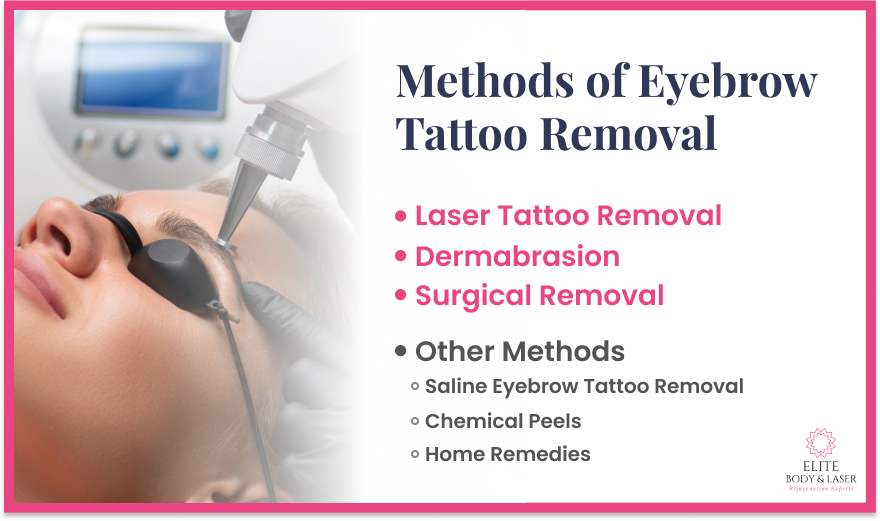Eyebrow tattoo removal is an important topic for anyone looking to reverse a previous beauty decision or adapt to new trends.
In this guide, you’ll find everything you need to know about safely and effectively removing your eyebrow tattoo.
From cutting-edge techniques to essential aftercare, this guide will empower you with the knowledge to make a decision that feels right for you.

Understanding Eyebrow Tattoo Removal
Eyebrow tattoo removal is a specialized process that eliminates unwanted pigment from the skin, specifically in the eyebrow area. This procedure is often sought after by individuals who have undergone eyebrow tattooing or microblading but wish to remove or alter the appearance of their eyebrows.
Eyebrow Tattooing vs Microblading
Traditional eyebrow tattoos are done using a machine and involve implanting ink deeper into the skin, much like a regular body tattoo.
Microblading, on the other hand, is a form of semi-permanent makeup removal that uses a hand-held tool to create finer, more superficial strokes that mimic the appearance of natural eyebrow hairs.
The removal techniques for these two methods can differ. Tattoos, being deeper and often more saturated, might require more intensive removal methods. Microblading, being more superficial, can sometimes be more accessible to fade or remove.
Why Consider Eyebrow Tattoo Removal?
- Dissatisfaction with Results: Sometimes, the outcome of an eyebrow tattoo or microblading needs to meet expectations. The shape, color, or density might not be desired, leading to the wish for removal.
- Change in Trends or Personal Style: Beauty trends evolve, and what was once in Vogue might not align with current styles or personal preferences. As such, individuals may remove their eyebrow tattoos to better match their current aesthetic or keep up with the latest beauty standards. This adaptability allows for a refreshed look that resonates more closely with their evolving style.
- Personal Preference and Life Changes: Personal circumstances and preferences change over time. What once seemed like a perfect fit for one’s appearance might no longer feel suitable. This change in personal taste is a common reason for seeking eyebrow tattoo removal.
- Health Considerations: In some cases, individuals might experience allergic reactions or skin sensitivities to the pigments used in eyebrow tattoos. Additionally, as the skin ages, tattooed areas might change in appearance, prompting a need for removal. It’s also possible that a medical condition or treatment plan necessitates the removal of any skin tattoos, including those on the eyebrows.

Methods of Eyebrow Tattoo Removal
Each eyebrow tattoo removal method comes with its own set of advantages and disadvantages. It’s crucial to consult with a professional to determine the most suitable method based on your specific tattoo, skin type, and overall health.
Laser Tattoo Removal
Laser eyebrow tattoo removal is one of the most advanced and commonly used methods for eyebrow tattoo removal. The laser emits a specific wavelength of light absorbed by the pigment in the tattoo. This light energy heats and breaks down the pigment into smaller particles, which are then naturally eliminated by the body’s immune system.
The most common laser treatments for tattoo removal include the Q-switched Nd: YAG, Q-switched Alexandrite, and the newer PicoSure laser. Each type is effective on different pigment colors and skin types.
Pros and Cons:
- Pros: Highly effective, particularly on darker inks; minimal damage to surrounding skin; can be adjusted for different skin types and ink colors.
- Cons: Multiple sessions are required; they can be painful; there is a risk of skin discoloration and scarring; they are typically more expensive than other methods.
Dermabrasion
Dermabrasion involves mechanically sanding down skin layers to remove the ink. This method can be effective for eyebrow tattoos, but its suitability depends on the depth and density of the ink, as well as the individual’s skin type.
Pros and Cons:
- Pros: Can be effective for superficial tattoos; less expensive than laser removal.
- Cons: Can be painful and require local anesthesia; risk of scarring and infection; not suitable for all skin types and tattoo depths.
Surgical Removal
Surgical removal is a more invasive method, typically recommended for small tattoos where excision is feasible or when other procedures have failed.
The tattooed skin is surgically cut out, and the remaining skin is stitched together. Recovery involves wound care and monitoring for any signs of infection.
Pros and Cons:
- Pros: Immediate tattoo removal; effective when other methods are unsuitable.
- Cons: Leaves a scar; risk of infection; requires local or general anesthesia.
Other Methods
- Saline Eyebrow Tattoo Removal: This involves tattooing a saline solution into the eyebrow hair, which helps to fade the tattoo by pulling out the ink.
- Chemical Peels: Use of acid solutions to remove the top layers of skin, which can gradually fade the tattoo.
- Home Remedies: Lemon juice, honey, or aloe vera may be used. These are generally less effective and potentially risky.
Pros and Cons:
- Pros: Less expensive; some can be done at home.
- Cons: Less effective; higher risk of skin damage and ineffective results; potential for adverse reactions.

Eyebrow Tattoo Removal Process
How the eyebrow tattoo removal works depends on the method, but here’s a general step-by-step walkthrough for laser removal — the most common technique used:
- Consultation: Before the procedure, you’ll have a consultation with a specialist to discuss your medical history, skin type, and the specifics of your eyebrow tattoo.
- Preparation: The area around your eyebrows will be cleaned, and you might be given protective eyewear. A topical anesthetic cream may be applied to minimize discomfort.
- The Procedure: The laser technician will pass the laser device over your eyebrows, emitting light pulses. You’ll feel a sensation similar to the snap of a rubber band against the skin.
- Duration: Each session typically lasts between 15 to 30 minutes, depending on the size and complexity of the eyebrow tattoo.
- Pain Management and Anesthesia: Most people experience some discomfort during laser removal. Topical anesthetics are commonly used to numb the area. In some cases, local anesthesia or pain relief medications might be recommended.
Aftercare and Healing
Remember, the eyebrow removal treatment process is a journey that requires patience and adherence to aftercare instructions.
Each person’s experience and healing process can vary, so it’s important to maintain realistic expectations and follow the guidance of your removal specialist.
Post-Treatment Care Instructions:
- Apply any prescribed or recommended ointments or creams.
- Keep the area clean and dry.
- Avoid direct sunlight and use a high-SPF sunscreen to protect the treated area.
- Refrain from picking at any scabs or blisters to prevent scarring.
Healing Time and What to Expect:
- The treated area may be red, swollen, or slightly bruised for a few days.
- Complete healing typically takes several weeks.
- Multiple sessions, usually spaced 6 to 8 weeks apart, are often necessary for complete removal.
Potential Side Effects and How to Manage Them:
- Temporary side effects can include redness, swelling, blistering, and changes in skin pigmentation.
- Rarely, scarring or infection may occur.
- Consult your specialist immediately if you experience any severe or prolonged side effects.
Eyebrow Tattoo Removal Treatment Cost and Considerations
When considering eyebrow tattoo removal, understanding the financial aspect is as important as knowing the procedure. Costs can vary widely based on several factors.
Average Cost of Different Removal Methods
- Laser Removal: This is often the most expensive option, with prices ranging from $200 to $500 per session. The total cost depends on the number of sessions needed, which can vary based on the tattoo’s size, color, and age.
- Dermabrasion: Dermabrasion costs between $100 and $300 per session. Like laser removal, multiple sessions may be required.
- Surgical Removal: This method might be a one-time procedure, with costs typically ranging from $500 to $1,000, depending on the complexity of the surgery.
- Other Methods (Saline, Chemical Peels, etc.): These are generally less expensive, varying widely depending on the specific treatment and provider.
Factors Influencing the Cost
- Size and Complexity of the Tattoo: Larger or more complex tattoos require more time and resources to remove, increasing the cost.
- Type of Removal Method: Different methods come with different price tags, as outlined above.
- Number of Sessions Required: Some tattoos can be removed in a few sessions, while others may need many, impacting the overall cost.
- Geographical Location: Costs can vary significantly depending on where you live and the availability of specialized services in your area.
- Expertise of the Provider: Experienced professionals or specialized clinics might charge more due to their knowledge and the quality of the technology they use.
Insurance and Financial Considerations
It’s important to note that eyebrow tattoo removal is generally considered a cosmetic procedure and is not typically covered by health insurance.
However, there are a few considerations:
- Payment Plans: Some clinics offer payment plans to help manage the cost over time.
- Consultations: Some providers offer free consultations, which help you understand the total cost before committing to the procedure.
- Special Offers: Look out for special offers or discounts, which some clinics provide, especially during promotional periods.
Take the Next Step in Your Eyebrow Tattoo Removal Journey with Expert Care
With the comprehensive information provided, you’re now equipped with the knowledge to make an informed decision. Remember, the success of this process hinges not just on the method chosen but also on the expertise of the professionals you entrust with your care.
By choosing our services, you’re not just getting treatment; you’re gaining a partner committed to helping you achieve the best possible results. Contact us today and take the first step toward a new chapter in your beauty journey.

